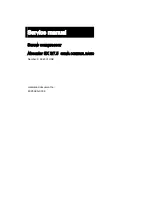
070.655-IOM (FEB 22)
Page 17
SBTP Rotary Screw Compressor
Installation
shaft and motor shaft to allow for seal removal. See
the relevant outline drawings in
to
.
• The coupling must be able to take up any misalignment
between motor and compressor. It is critical to the life
of the shaft seal that misalignment is kept to the mini-
mum possible value. Ensure you follow the coupling
manufacturer’s guidelines for checking and correcting
any misalignment.
Aligning the coupling
You must perform a coupling alignment before start-up:
1. After installing the compressor on the job site, check
the alignment again and correct if necessary before
start-up.
2. After a few hours operation, check the alignment while
the package is still hot. Correct hot alignment is criti-
cal to ensure the life of the shaft seal and compressor
bearings.
Note:
The maximum radial runout is 0.004 in. total indica-
tor reading. The maximum axial runout is 0.004 in.
total indicator reading.
3. Use a dial indicator or another appropriate measuring
device to determine the total indicator runout.
4. Check the indicator bracket sag because all brackets
have some flexibility. The best way to measure this is
as follows:
a. Attach the dial indicator and bracket on a pipe at the
coupling span distance.
b. Zero the indicator in the 12:00 position.
c. Rotate the pipe so the indicator is in the 6:00
position. The reading on the indicator in the 6:00
position is the bracket sag.
You must include this value in the dial indicator readings
when affixed to the coupling for an accurate alignment.
Oil heaters
Your package must be equipped with oil heaters that
provide sufficient heat to prevent condensation from oc
-
curring during shutdown cycles. In addition, Frick strongly
suggests heat tracing for all of the lube oil lines includ-
ing oil filters and the oil cooler. Activate the heat tracing
during compressor shutdown to ensure that all of the lube
system is up to the correct temperature before startup.
Oil filters
Using filter elements other than Johnson Controls-Frick
must be approved in writing by Johnson Controls-Frick
engineering or a warranty claim may be denied. Typical
oil filter specification
β
5 = 75 according to ISO 4572 is
required to obtain the recommended oil cleanliness class
16/14/11 according to ISO 4406.
Oil cooling requirements
Compressor oil needs to be cooled to control the discharge
temperature, maintain the appropriate oil viscosity, and to
preserve the life of the oil. Normally the discharge tempera-
ture is between 170°F to 180°F. See CoolWare
™
to determine
your configuration.
The main oil injection line that is connected to port SM1 must
have a regulating valve to permit adjustment of the oil flow to
maintain the appropriate discharge temperature at all times.
Frick suggests using a three-way mixing valve to keep the
oil temperature in the normal range of 120°F to 140°F.
The valve provides warm oil to the compressor quickly, re-
ducing the pressure drop caused by cold, viscous oil. This
ensures the correct oil flow and temperature over the full
range of operating conditions.
While liquid injection oil cooling is an option for anti-
friction Frick screw compressors, it is not recommended
for compressors supplied with tilting pad thrust bearings.
Acceptable methods of oil cooling would use either water,
air, or refrigerant cooled oil coolers.
Natural gas applications
One application that usually requires higher discharge
temperatures, as high as 250°F, is natural gas gathering at
the wellhead. Moisture is normally present in the gas and
it is imperative that the discharge temperature be at least
30°F higher than the discharge dew point temperature for
the gas.
1. Open CoolWare and from the
Wet/Dry Mode
list, se-
lect
Water Saturated
.
2. Select
Calculate
to get the discharge dew point tem-
perature for your application.
Oil temperatures as high as 170°F can be used to achieve
the necessary discharge temperature to prevent moisture
from condensing in the oil separator. Contact Johnson
Controls–Frick for additional information for natural gas
compression.
Dehydration or evacuation test
Evacuate the system to 1000 microns. Valve off the
vacuum pump and hold vacuum for 1 h.
Pass:
vacuum cannot rise more than 500 microns during
1 h hold period.
Fail
: vacuum rise is more than 500 microns during 1 h
hold period. Identify and repair any system leaks. Repeat
vacuum test until requirements are met.
















































